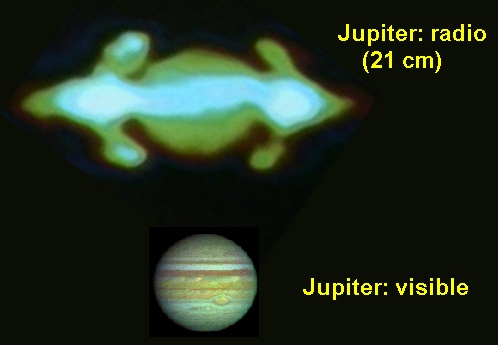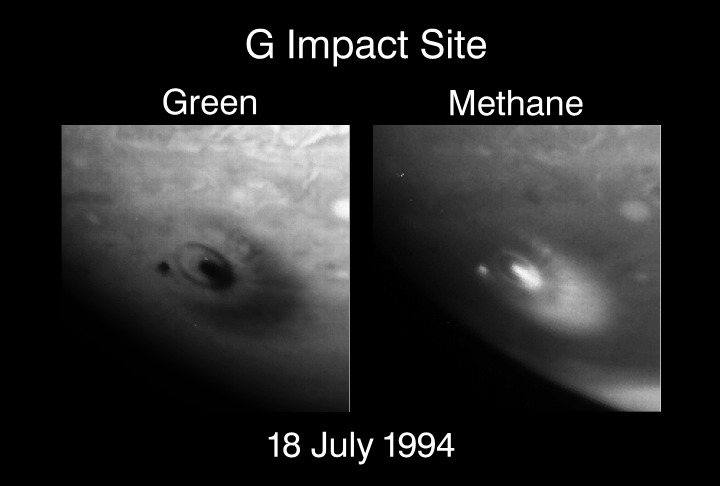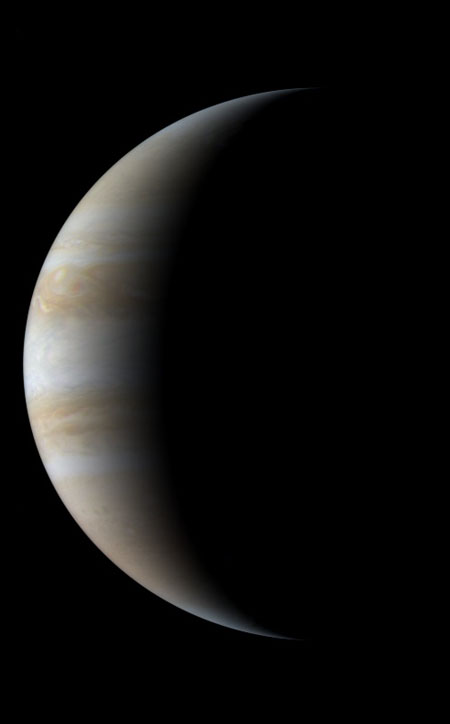Skip to comments.
Astronomy Picture of the Day 3-09-03
NASA ^
| 3-09-03
| Robert Nemiroff and Jerry Bonnell
Posted on 03/08/2003 10:14:04 PM PST by petuniasevan
Astronomy Picture of the Day
Discover the cosmos! Each day a different image or photograph of our fascinating universe is featured, along with a brief explanation written by a professional astronomer.
TOPICS: Astronomy; Astronomy Picture of the Day; Science
KEYWORDS: astronomy; belts; cassini; clouds; crescent; huygens; image; jupiter; outbound; phase; photography; probe; redspot; saturn; solarsystem; space; spacecraft; titan
Jupiter is not only an incredible sight in visible light, it is radio noisy.
Radio emission from Jupiter was first discovered at decametric wavelengths by Franklin and Burke in 1955. Since that time, Jupiter has proven to have a wealth of complex radio emission mechanisms. Below 40 MHz, cyclotron-maser emission dominates, with much of this being associated with the rotational phase of the volcanic moon Io. Between 40 MHz and a few GHz, the radio emission is dominated by synchrotron emission from magnetically trapped, highly relativistic electrons, which populate the region within a few Jovian radii of the planet. At higher frequencies, the thermal emission from the planet itself dominates -- Jupiter is often used as a calibrator at high frequencies.

Jupiter is also bright at some infrared wavelengths (and dark at others). The bright spot is moon Io.

Jupiter in ultraviolet (Hubble image) in 1994 soon after the collisions with fragments of comet Shoemaker-Levy 9.

Chandra image of Jupiter in X-rays.

To: MozartLover; Joan912; NovemberCharlie; snowfox; Dawgsquat; viligantcitizen; theDentist; ...
2
posted on
03/08/2003 10:15:02 PM PST
by
petuniasevan
(cogito, ergo spud: I think, therefore I yam...)
To: petuniasevan
Amazing images, petuniasevan! I'm always fascinated by the pics featuring impact with fragments from the Showmaker-Levy/9 comet. I sometimes wonder if the scientists detected any change in the appearance or composition of Jupiter's bands after the the strike. It seems like an impact on Earth from any of the fragments would have had a a cataclysmic effect that we'd still be reeling from.
3
posted on
03/08/2003 11:07:21 PM PST
by
BradyLS
To: BradyLS
impact on Earth from any of the fragments would have had a a cataclysmic effect The spectacular collision of comet fragment G: it struck Jupiter with an estimated energy equivalent to 6,000,000 megatons of TNT (about 600 times the estimated arsenal of the world). The fireball from fragment G rose about 2000 miles above the Jovian cloudtops and was observed by many observatories (mostly in infrared).
Fragment G was about 2 miles in diameter. Cataclysmic wouldn't begin to describe an impact of such an object with Earth. "Total obliteration" is the term you're looking for.
This is a reason why it's so handy having Jupiter out there in harm's way. Its huge gravity well pulls in many comets that otherwise could impact us.


Hubble images of the Fragment G impact site. Note the "sooty" area. It's larger than the diameter of Earth.

MSSSO Image of Fragment G Impact Zone
This image shows the bright fireball caused by the impact of fragment G with Jupiter. This view of the impact, seen 12 minutes after the actual collision, was taken in infrared light with a camera at the Mount Stromlo and Siding Springs Observatory in Australia. Due to Jupiter's tremendous size compared to the comet, astronomers did not expect the collisions to provide such dramatic effects as that seen in this image.

HST Image of Comet Fragment G Impact Plume
This series of images depicts the development of an explosive plume arising from the collision of fragment G. Scientists believe that the plume is not detached from Jupiter, as the pictures imply. Instead, only the portion of the plume that has risen into the sunlight is visible while the lower portion is hidden by Jupiter's shadow. The plume feature expands over the 18 minute period shown here and is visible in a variety of wavelengths across the spectrum.
4
posted on
03/08/2003 11:51:03 PM PST
by
petuniasevan
(cogito, ergo spud: I think, therefore I yam...)
To: BradyLS; All
5
posted on
03/09/2003 12:00:07 AM PST
by
petuniasevan
(cogito, ergo spud: I think, therefore I yam...)
To: BradyLS
6
posted on
03/09/2003 12:05:27 AM PST
by
petuniasevan
(cogito, ergo spud: I think, therefore I yam...)
To: petuniasevan
That is so incredibly cool! I absolutely love seeing images of other planets! Thanks so much! :)
7
posted on
03/09/2003 6:10:53 AM PST
by
Joan912
(couldn't think of a witty line...)
To: petuniasevan
Good morning, thanks for the ping
8
posted on
03/09/2003 6:12:53 AM PST
by
firewalk
To: petuniasevan
"This is a reason why it's so handy having Jupiter out there in harm's way. Its huge gravity well pulls in many comets that otherwise could impact us."
Let us all be thankful for Jupiter. Awesome photos and information about the SL9 impact. Fragment G left a larger-than-earth size scar? Ouch.
9
posted on
03/09/2003 6:38:15 AM PST
by
xJones
To: petuniasevan
There's all the hydrogen we'll ever need to power our buggies to the mall and back.
10
posted on
03/09/2003 10:28:21 AM PST
by
RightWhale
(Theorems link concepts: Proofs establish links)
To: petuniasevan
Fascinating images, bye Jove!
11
posted on
03/09/2003 10:51:48 AM PST
by
mikrofon
(Pax Americana)
To: petuniasevan
Great images!
To: petuniasevan
Great work, beautiful images, keep it up!
APOD my favorite site!
To: petuniasevan
Very beautiful, thank you!
14
posted on
03/09/2003 6:35:05 PM PST
by
MozartLover
(Hanging on for dear life)
Disclaimer:
Opinions posted on Free Republic are those of the individual
posters and do not necessarily represent the opinion of Free Republic or its
management. All materials posted herein are protected by copyright law and the
exemption for fair use of copyrighted works.
FreeRepublic.com is powered by software copyright 2000-2008 John Robinson









